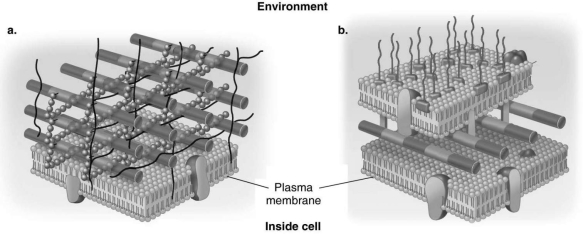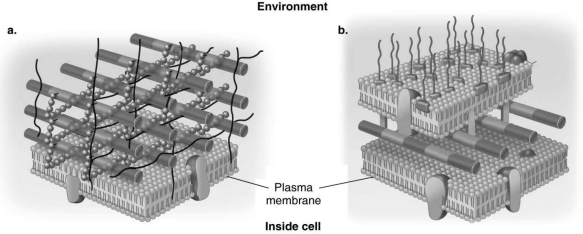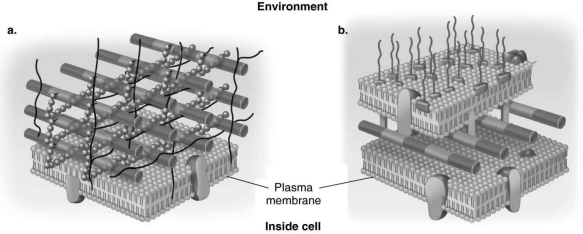A) a
B) b
C) both a and b
D) neither a nor b
E) The answer cannot be determined based on the information provided.
G) B) and D)
Correct Answer

verified
Correct Answer
verified
Multiple Choice
In a hypertonic solution, a bacterial cell will typically
A) stay the same.
B) plasmolyze.
C) lyse.
D) burst.
E) osmolyze.
G) D) and E)
Correct Answer

verified
Correct Answer
verified
Multiple Choice
Which of the following is NOT part of the passive transport process?
A) concentration gradient
B) ATP
C) transporter proteins
D) aquaporins
E) plasma membrane
G) A) and C)
Correct Answer

verified
Correct Answer
verified
Multiple Choice
Figure 4.3
 -In Figure 4.3, which diagram of a cell wall contains teichoic acids?
-In Figure 4.3, which diagram of a cell wall contains teichoic acids?
A) a
B) b
C) both a and b
D) neither a nor b
E) The answer cannot be determined based on the information provided.
G) B) and E)
Correct Answer

verified
Correct Answer
verified
Multiple Choice
Which of the following is NOT a typical characteristic of most bacterial plasma membranes?
A) contains cholesterol
B) contains proteins
C) composed of a phospholipid bilayer
D) site of energy production
E) is selectively permeable
G) B) and C)
Correct Answer

verified
Correct Answer
verified
Multiple Choice
Figure 4.3
 -In Figure 4.3, which diagram of a cell wall is decolorized by alcohol?
-In Figure 4.3, which diagram of a cell wall is decolorized by alcohol?
A) a
B) b
C) both a and b
D) neither a nor b
E) The answer cannot be determined based on the information provided.
G) None of the above
Correct Answer

verified
Correct Answer
verified
Multiple Choice
In bacteria, photosynthetic pigments are found in
A) cytoplasm.
B) chloroplasts.
C) ribosomes.
D) chromatophores.
E) mesosomes.
G) B) and D)
Correct Answer

verified
Correct Answer
verified
Multiple Choice
Which of the following statements is correct about diffusion?
A) It may require a transport protein.
B) It requires an expenditure of energy by the cell.
C) It is a passive process in which molecules move from a region of higher concentration to a region of lower concentration.
D) It involves movement of molecules down a concentration gradient and may require a transport protein.
E) It is an active process in which molecules move from a region of lower concentration to one of higher concentration.
G) B) and E)
Correct Answer

verified
Correct Answer
verified
Multiple Choice
Which of the following pairs is mismatched?
A) mitochondria - ATP production
B) lysosome - digestive enzymes
C) Golgi complex - secretion
D) centrosome - food storage
E) endoplasmic reticulum - internal transport
G) C) and E)
Correct Answer

verified
Correct Answer
verified
Multiple Choice
Where are phospholipids most likely found in a eukaryotic cell?
A) the plasma membrane
B) surrounding flagella
C) ribosomes
D) around organelles
E) the plasma membrane, around organelles, and surrounding flagella
G) B) and E)
Correct Answer

verified
Correct Answer
verified
Multiple Choice
Functions of the glycocalyx include all of the following EXCEPT
A) biofilm formation.
B) source of nutrition.
C) increased virulence.
D) binary fission.
E) protection against dehydration.
G) A) and B)
Correct Answer

verified
Correct Answer
verified
Multiple Choice
Which of the following statements is TRUE?
A) A cell can produce many endospores.
B) Endospores allow a cell to survive environmental changes.
C) A cell produces one endospore and keeps growing.
D) Endospores are for reproduction.
E) Endospores are easily stained in a Gram stain.
G) A) and B)
Correct Answer

verified
Correct Answer
verified
Multiple Choice
You have isolated a motile, gram- positive cell with no visible nucleus. You can safely assume that the cell
A) has 9 pairs + 2 flagella.
B) lives in an extreme environment.
C) has a mitochondrion.
D) has a cell wall.
E) has cilia.
G) A) and D)
Correct Answer

verified
Correct Answer
verified
Multiple Choice
The difference between simple diffusion and facilitated diffusion is that facilitated diffusion
A) moves materials from a lower to a higher concentration.
B) requires transporter proteins.
C) requires ATP.
D) does not require ATP.
E) moves materials from a higher to a lower concentration.
G) B) and C)
Correct Answer

verified
Correct Answer
verified
Multiple Choice
What will happen if a bacterial cell is placed in distilled water with lysozyme?
A) The cell will plasmolyze.
B) Water will leave the cell.
C) Lysozyme will diffuse into the cell.
D) The cell will undergo osmotic lysis.
E) No change will result; the solution is isotonic.
G) A) and E)
Correct Answer

verified
Correct Answer
verified
True/False
The internal structure of eukaryotic cilia and flagella are the same.
B) False
Correct Answer

verified
Correct Answer
verified
Multiple Choice
Figure 4.3
 -In Figure 4.3, which diagram of a cell wall is resistant to many antibiotics (e.g., penicillin) ?
-In Figure 4.3, which diagram of a cell wall is resistant to many antibiotics (e.g., penicillin) ?
A) a
B) b
C) both a and b
D) neither a nor b
E) The answer cannot be determined based on the information provided.
G) A) and C)
Correct Answer

verified
Correct Answer
verified
True/False
Spheroplasts, protoplasts, and mycoplasms are bacterial cells without cell walls.
B) False
Correct Answer

verified
Correct Answer
verified
Multiple Choice
Oxygen crosses a plasma membrane
A) through simple diffusion.
B) with the help of a nonspecific transporter.
C) by osmosis.
D) through facilitated diffusion.
E) through porins.
G) A) and B)
Correct Answer

verified
Correct Answer
verified
Multiple Choice
Each of the following statements concerning the gram- positive cell wall is true EXCEPT
A) it protects the cell in a hypertonic environment.
B) it is sensitive to lysozyme.
C) it maintains the shape of the cell.
D) it is sensitive to penicillin.
E) it contains teichoic acids.
G) A) and C)
Correct Answer

verified
Correct Answer
verified
Showing 21 - 40 of 56
Related Exams